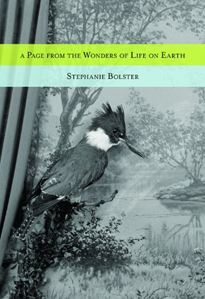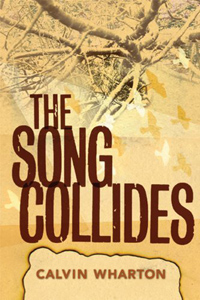Reviews
Poetry Review by Shane Rhodes
Stephanie Bolster, A Page from the Wonders of Life on Earth (London: Brick, 2011). Paperbound, 76 pp., $19.
Calvin Wharton, The Song Collides (Vancouver: Anvil, 2011). Paperbound, 80 pp., $16.
One question I think about increasingly is the use of poetry as exposition, poetry in that middle ground between expository prose and lyric. In this, poetry tries to be both a vehicle for knowledge (“look at the research I did and the things I found”) and a space for poetic play. At its best are stellar examples like Phil Hall’s Killdeer, where poetry begins to disintegrate and rebuild itself under the opposing forces of lyric, narrative, and exposition, to create a hybrid genre that allows for the free play of story, ideas, and sound. At the other end, one can sometimes wonder why poetry, instead of an essay, is being used at all. This isn’t to enter into mundane arguments of what is/isn’t poetry, but to look more closely at the generative potential of this space between poetry as art and poetry as an investigative and expositional tool.
Stephanie Bolster’s A Page from the Wonders of Life on Earth takes its
title from  The Wonders of Life on Earth, a book produced in the early sixties
that featured text by Lincoln Barnett and a menagerie of animal
photos from around the world. This beginning frame (a page from a
book within a book) highlights a theme that runs strong throughout:
that the viewed is never unmitigated, that the natural world—if such
a distinction exists—is always already predigested, or seen through
curatorial frames of others. With this theme, images of glass, lenses,
shutters, frames, people looking and viewing, tick through the book
like clockwork. For example, the poem “Versailles” ends with “the
queen / gave birth, watched by whomever came to watch.” In “Life of
the Mind (Wonders),” “Bars predominate the first ape-taken photos. /
Bars and human faces, some obscured by cameras.” “Comfort” gives
us a man who puts his face to the chimpanzee’s glass while “Underneath,
the metro runs / faces he could spend an hour watching / if the
earth were made of glass.” With these images of viewing/being
viewed, zoological and botanical gardens become the book’s natural
setting. Anyone familiar with Bolster’s work will know of her interest
in zoos from her recent project, Penned: Zoo Poems (Signal, 2009). A
Page from the Wonders of Life on Earth is an almost academic history of
these cultivated spaces of domesticated wilderness, touring through
Regent’s Park Zoo, Central Park Zoo, Brussels Zoo, before moving to
modern-day conundrums like bombed-out zoos in Kabul, Baghdad,
and Dhaka. We look at bear pits, topiaries, solariums, aviaries, Kew
Gardens, Versailles, and even drop in to Montreal’s Biodôme. Bolster’s
thorough investigation of gardens and zoos in their many different
forms feels academic at times. But, for all that, the book’s thesis is
engaging and takes us beyond the garden to what I think is the core
concern of this book: that the Victorian-era industrial growth of the
city continues to shape our relationship to, and understanding of, the
natural world. One could well imagine this book as an elegy for what
has been lost in the creation of urban environments. But, unlike, say,
Rita Wong’s Forage or Melanie Siebert’s Deepwater Vee, Bolster’s book
isn’t so much interested in the destruction as in the thinking that
allows the destruction to happen in the first place.
The Wonders of Life on Earth, a book produced in the early sixties
that featured text by Lincoln Barnett and a menagerie of animal
photos from around the world. This beginning frame (a page from a
book within a book) highlights a theme that runs strong throughout:
that the viewed is never unmitigated, that the natural world—if such
a distinction exists—is always already predigested, or seen through
curatorial frames of others. With this theme, images of glass, lenses,
shutters, frames, people looking and viewing, tick through the book
like clockwork. For example, the poem “Versailles” ends with “the
queen / gave birth, watched by whomever came to watch.” In “Life of
the Mind (Wonders),” “Bars predominate the first ape-taken photos. /
Bars and human faces, some obscured by cameras.” “Comfort” gives
us a man who puts his face to the chimpanzee’s glass while “Underneath,
the metro runs / faces he could spend an hour watching / if the
earth were made of glass.” With these images of viewing/being
viewed, zoological and botanical gardens become the book’s natural
setting. Anyone familiar with Bolster’s work will know of her interest
in zoos from her recent project, Penned: Zoo Poems (Signal, 2009). A
Page from the Wonders of Life on Earth is an almost academic history of
these cultivated spaces of domesticated wilderness, touring through
Regent’s Park Zoo, Central Park Zoo, Brussels Zoo, before moving to
modern-day conundrums like bombed-out zoos in Kabul, Baghdad,
and Dhaka. We look at bear pits, topiaries, solariums, aviaries, Kew
Gardens, Versailles, and even drop in to Montreal’s Biodôme. Bolster’s
thorough investigation of gardens and zoos in their many different
forms feels academic at times. But, for all that, the book’s thesis is
engaging and takes us beyond the garden to what I think is the core
concern of this book: that the Victorian-era industrial growth of the
city continues to shape our relationship to, and understanding of, the
natural world. One could well imagine this book as an elegy for what
has been lost in the creation of urban environments. But, unlike, say,
Rita Wong’s Forage or Melanie Siebert’s Deepwater Vee, Bolster’s book
isn’t so much interested in the destruction as in the thinking that
allows the destruction to happen in the first place.
A Page from the Wonders of Life on Earth also displays an interesting clash of sensibilities and form. For a project like this, there is the real possibility that its poetry can be overwhelmed by the ideas it explores and the knowledge it wishes to impart; in turn, this can throw into question the use of poetry when expository prose, or something in between, may be better suited for all the demands placed on it. Through the book’s “Life of the Mind” series, where her poetic conventions break down into a much more loose and jagged prose, Bolster evinces these same reservations:
On Jersey, Durrell built the zoo for them—the animals, not
us—with money made by writing about trips abroad in
search of them. (Of course I went.)
Locked in a room of aye-ayes
in the dark, I thought that was it.
In Paris, Rousseau, “Le Douanier,” painted, after visits to
the Jardin d’hiver, those velvet panthers. He never left
France.
“Life of the Mind (Sanctuary)”
This interplay within and between forms—between cultivated Victorian
control and, what? the wild? post-industrial chaos?—could be
more effectively explored, as in Cole Swenson’s Ours, for example,
with its disjunctive look at seventeenth-century French baroque gardens. In Bolster’s book, I got the sense, though, of a wildness thoroughly
vanquished and fenced; there are bars on the windows and we
see a landscape, with poems to match, as intricately manicured and
precisely engineered as a gated community.
The back-cover description would have you believe that Calvin Wharton’s
The Song Collides is a “highly personal metaphysical investigation
into the state of the natural world.”  However, the investigative attention
that Wharton musters is diffused, unfocused, and domestic. With
the necessary mixture of jazz allusions, classical music, and personal
vignettes, I felt at times, while reading The Song Collides, that I was in
a house with large picture windows, where music was pumped
through unseen speakers, and pictures of strangers, taken in places I’d
never been, lined the shelves. The Song Collides is less a book about the
natural world than about a person who sees things, lives them, and
then writes poems about them. Is this an “investigation,” or “metaphysics”?
I don’t think so; and such pretensions mask a project that is,
in essence, simple and personal. I would argue that, at its best, this
book looks at the surprising spaces where cultures, travels, death, and
love collide. The strongest poems are from the second section, “Borrowing
Scenery,” that combines poems about the death of a father
with travels in Asia.
However, the investigative attention
that Wharton musters is diffused, unfocused, and domestic. With
the necessary mixture of jazz allusions, classical music, and personal
vignettes, I felt at times, while reading The Song Collides, that I was in
a house with large picture windows, where music was pumped
through unseen speakers, and pictures of strangers, taken in places I’d
never been, lined the shelves. The Song Collides is less a book about the
natural world than about a person who sees things, lives them, and
then writes poems about them. Is this an “investigation,” or “metaphysics”?
I don’t think so; and such pretensions mask a project that is,
in essence, simple and personal. I would argue that, at its best, this
book looks at the surprising spaces where cultures, travels, death, and
love collide. The strongest poems are from the second section, “Borrowing
Scenery,” that combines poems about the death of a father
with travels in Asia.
it’s illegal now to publish the Chinese numerals
according to Mr. Tan, and when a student asks
how to say “my drain is plugged,” he mis-hears,
writes quick characters on the blackboard
then translates as “my dream has begun.”
“Big Study (1)”
Given the emotional weight of this section, it is interesting more space
isn’t dedicated to it, or to travel poetry in general, especially given the
book’s thematically labelled first and last sections “The Gate” and “Exit.”
Both of these books highlight the challenges of expository poetry, a poetry enamored with the explanation of ideas and the transference of knowledge. At times, you can get ideas beyond what the poetry can seem to muster. However, when it’s working, you get a sense of a mind building poetry at the same time it builds an argument, which can move us beyond lyrical niceties to a more textured interplay of ideas, images, and investigations.
—Shane Rhodes









